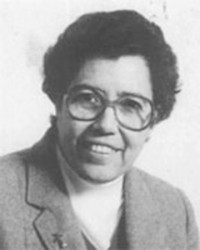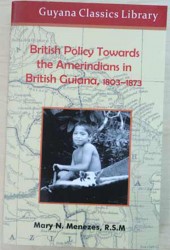 Last week we paid attention to some elements of the power of the Amerindian presence in Guyanese culture. Included in that was mention of the contribution to the great store of Guyanese literature and the corpus of Guyanese Amerindian literature. In deference to the celebration of September (last month) as Amerindian Heritage month in Guyana, we round off this treatment of the subject with a brief, closer look at some of the contributions by Guyanese researchers, but in particular, the work of Mary Noel Menezes, RSM.
Last week we paid attention to some elements of the power of the Amerindian presence in Guyanese culture. Included in that was mention of the contribution to the great store of Guyanese literature and the corpus of Guyanese Amerindian literature. In deference to the celebration of September (last month) as Amerindian Heritage month in Guyana, we round off this treatment of the subject with a brief, closer look at some of the contributions by Guyanese researchers, but in particular, the work of Mary Noel Menezes, RSM.
We mentioned that the Amerindian factor constitutes a substantial volume of Guyanese literature by both foreign and native authors who have provided wide and extremely interesting coverage of this subject. This coverage, of course, is varied and has been contributed to by scientists, botanists, geographers, explorers, administrators, artists, anthropologists and historians among other researchers. Our interest is mainly in the contributions to the documentation of Guyanese culture. This includes literature, art, oral literature, folklore, mythology, spiritual beliefs, cultural traditions, the theatrical and performance.
This literature may be grouped into historical periods: when it began with Ralegh in 1595; the nineteenth century and very early twentieth century; and work done since the middle to late twentieth century including by visiting and Guyanese researchers.

Culturally, Ralegh’s Discoverie of The Large, Rich and Bewtyful Empyre of Guiana, so often mentioned before, has endured as perhaps the most interesting and fascinating. It started off, not only Guyanese literature itself, but so much else in the national cultural legacy and preoccupations in the creative writing which seem never to be exhausted. Moreover, what fuels its evergreen interest is summarised thus by Menezes: “. . . a favourite courtier of Elizabeth I, set out to find the golden city to win glory for himself and gold for his Queen. For twenty three years the vision of El Dorado obsessed Raleigh. The price he paid to make the vision a reality was a heavy one: imprisonment, the death of his son, the suicide of his best officer, Captain Keymis, and finally his own execution. It was not in vain. He left a legacy to the world in the marvellous description of the richness and beauty of a country that would be a prize par excellence.”
The ‘ideal’, the romantic and the exotic Guyana glitters somewhere in that legacy until the corps of writers of the documents of the nineteenth century began to present the ‘real’ Guyana in their unflattering analyses. Yet many of those same writers saw the beauty that glowed for Ralegh. Menezes provides many commentaries to support this including the writings of Guyanese historian James Rodway (who belongs to the second period). Commenting on this “richness and beauty, and, above all, the possibility of untold wealth,” Rodway remarks, “The real Guiana was, however, quite as interesting as the ideal.”
There is no doubt about the richness of the folk culture as recorded by the nineteenth century writers and Walter Roth. Contemporary writers have added their own treatment to this, but the difference in attitude is often remarkable. There are several references to the piaiman, medicine man or shaman, in the unflattering nineteenth century accounts. He is regarded with contempt as a greedy, feared, lecherous and exploitative charlatan. Yet for contemporary anthropologist Audrey Butt Colson, the tradition and practice of the shaman is a part of the richness of the culture and the intricacies of the Amerindian spiritual beliefs. Her discussion of shamanistic rituals provide an analysis of theatrical performance that is the shaman’s method. Prof Menezes, Professor Emeritus and former Head of History at the University of Guyana is responsible for an excellent and comprehensive review of the documented history of the Amerindians in her succinct but thorough introduction to The Amerindians in Guyana 1803 to 73: A Documentary History edited by her in 1979. The work pulls together a collection of documents from primary sources. Menezes writes of practices “denounced by the zealous missionaries” including the belief in spirits and the piaiman. “The forest world of the Amerindian was dominated by spirits; more evil than good, hence his life was governed by these spirits of the trees, the waters of rivers, creeks, cataracts and falls, the rocks, birds and animals.” The piaiman therefore exerts great influence. She comments that “even after more than a century of Christianity this belief in the powers of the piaiman remains strong among the converted Indians.”
 Menezes’ introduction to The Amerindians in Guyana gives a very useful overview of the history of the colony and the attitudes and relationships between the colonisers and the Indians – the Spanish, the Dutch, the English, providing strong insights into the work of both the administrators and the researchers. These include Robert and Richard Schomburgk, William Hillhouse, Rev WH Brett, WCF McClintock, Sir Everard im Thurn and Walter Roth. She goes further to introduce much of the work of the twentieth century anthropologists.
Menezes’ introduction to The Amerindians in Guyana gives a very useful overview of the history of the colony and the attitudes and relationships between the colonisers and the Indians – the Spanish, the Dutch, the English, providing strong insights into the work of both the administrators and the researchers. These include Robert and Richard Schomburgk, William Hillhouse, Rev WH Brett, WCF McClintock, Sir Everard im Thurn and Walter Roth. She goes further to introduce much of the work of the twentieth century anthropologists.
Menezes, of course, devotes one of her publications to Hillhouse – she edits and introduces Indian Notices first in a 1978 publication which was reprinted by the Caribbean Press in 2013. She describes Hillhouse, who lived among the Amerindians, marrying one of them, between 1815 and 1840, as “one of the most versatile, interesting and controversial figures in the early history of British Guiana.” As an “unfailing advocate” of Amerindian rights, Menezes refers to him as a “Las Casas of British Guiana” who “did not hesitate to condemn the abuses of the system of government over the Indians, winning “the hearty dislike of Governors, Members of the Courts, Protectors of Indians, and Postholders.”
Among her most interesting works is the Introduction to Sketches of Amerindian Tribes 1841-1843 by Edward Goodall. Here she addresses a very important period in the history of art in Guyana, with the Amerindians as subjects. This is the art of the nineteenth century when Edward Goodall was employed to accompany Robert Schomburgk on his journeys through British Guiana and produced a valuable collection of paintings and drawings, documenting Amerindian peoples and their activities. These include landscapes, portraits, and a variety of pictures. Apart from Goodall’s work, there are pieces by W L Walton, Dr William Leary Echlin, WH Hedges, and Schomburgk-Bentley’s illustrations, before Goodall was hired by the explorer.
Hedges is a significant case and Menezes reproduces his painting In The Guiana Forests (1836), which she was instrumental in repatriating to Guyana. It was acquired by the National Bank of Industry and Commerce (now Republic Bank), but was unfortunately badly scorched by fire. The drawings and paintings produced prior to the twentieth century are more treated as a part of historical archives than a part of the national art. Menezes preserves the image of Hedges’s work on the cover of her The Amerindians and the Europeans (1992).
Among Menezes’s publications are also The Role of the Church in the Civilisation of the Amerindians in British Guiana 1803-1873 (1974), and British Policy towards the Amerindians in British Guiana 1803-1873 (1977).








